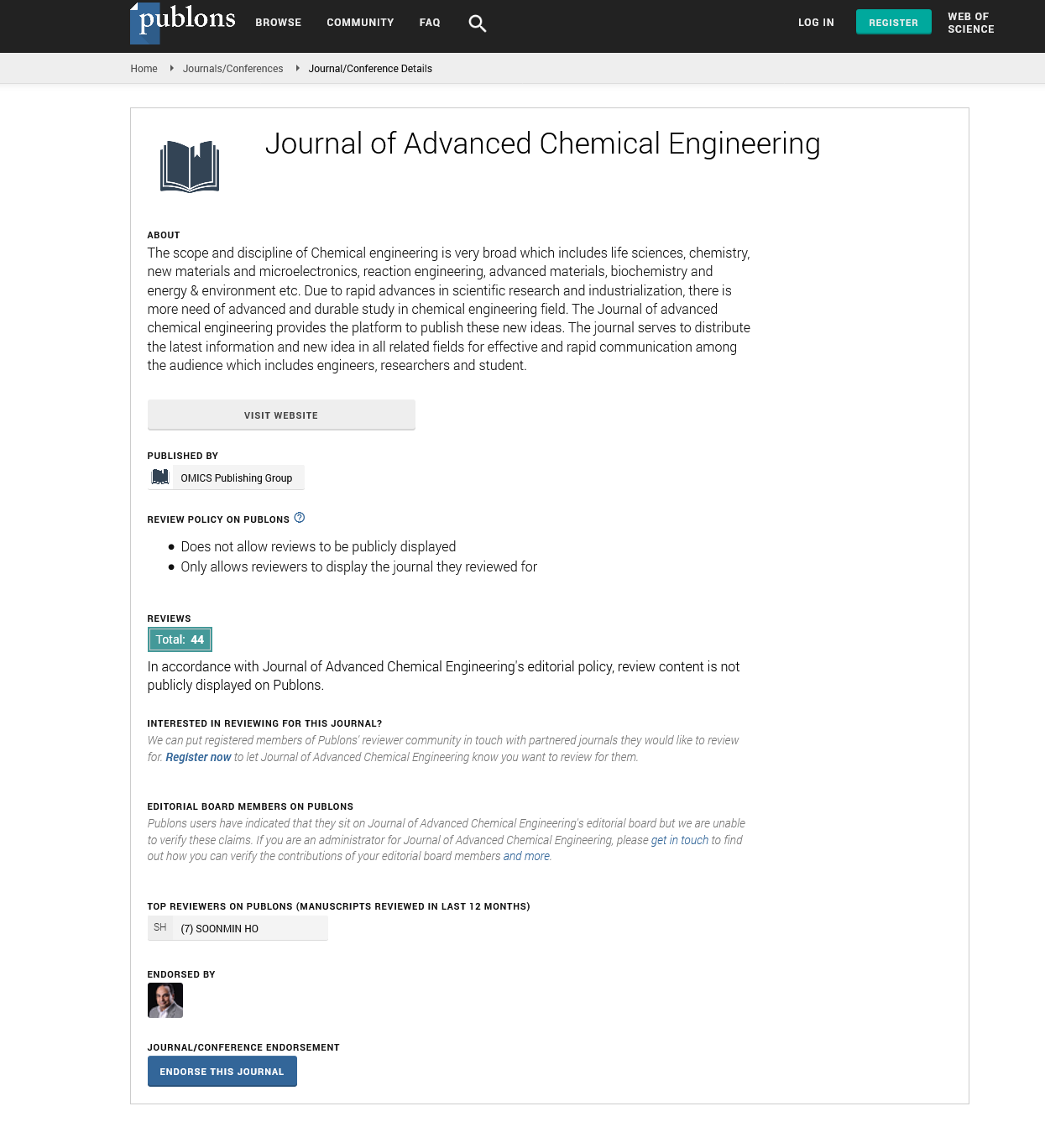Indexed In
- Open J Gate
- Genamics JournalSeek
- Smithers Rapra
- RefSeek
- Directory of Research Journal Indexing (DRJI)
- Hamdard University
- EBSCO A-Z
- OCLC- WorldCat
- Scholarsteer
- Publons
- Geneva Foundation for Medical Education and Research
- Google Scholar
Useful Links
Share This Page
Journal Flyer

Open Access Journals
- Agri and Aquaculture
- Biochemistry
- Bioinformatics & Systems Biology
- Business & Management
- Chemistry
- Clinical Sciences
- Engineering
- Food & Nutrition
- General Science
- Genetics & Molecular Biology
- Immunology & Microbiology
- Medical Sciences
- Neuroscience & Psychology
- Nursing & Health Care
- Pharmaceutical Sciences
Perspective - (2022) Volume 12, Issue 12
Prevention of Hazardous Chemicals used in Chemical Industries
Richi Stell*Received: 01-Dec-2022, Manuscript No. ACE-22-19357; Editor assigned: 06-Dec-2022, Pre QC No. ACE-22-19357 (PQ); Reviewed: 20-Dec-2022, QC No. ACE-22-19357; Revised: 26-Dec-2022, Manuscript No. ACE-22-19357 (R); Published: 04-Jan-2023, DOI: 10.35248/2090-4568.22.12.265
Description
The goal of this overview is to introduce the characteristics of a new family of dangerous chemicals known as chemosensitizers, which reduce multixenobiotic resistance (MXR) in aquatic species. MXR, a mechanism seen in aquatic species, is comparable to the well-known P-glycoprotein extrusion pump found in multidrug-resistant (MDR) tumour cells. In aquatic species, MXR transfers from cells and organisms as well as endogenous and xenobiotic substances, including certain synthetic compounds. MXR is a general biological first-line defence system for protection against environmental toxins seen in aquatic animals. Chemosensitizers, a class of chemical compounds, may interfere with the delicate mechanism's ability to function.
These compounds are ranked among the top dangerous water pollutants because of this brand-new, as of yet unrecognised MXR-inhibiting property. Knowing that one xenobiotic may prevent others from being pumped out and so speed up their accumulation may have significant effects on environmental factors like exposure, uptake, bioaccumulation, and toxicity. In this overview, we outline the evidence for MXR-phenotype expression in aquatic organisms, the harmful effects of MXR inhibitors, and the measuring techniques for MXR inhibitor levels in environmental samples.
In response to the introduction of more comprehensive and strict environmental and water legislation in the European Union, authorities were forced to evaluate the risk of noncompliance and develop the necessary pollution control strategies. The UK Water Industry has finished a national Chemicals Investigation Programme (CIP) to monitor over 160 wastewater treatment works (WwTWs) for 70 determinands in order to support this process. Final effluent concentrations of zinc, "penta" congeners (BDEs) 47 and 99, tributyltin, triclosan, erythromycin, oxytetracycline, ibuprofen, propranolol, fluoxetine, diclofenac, 17-estradiol, and 17-ethinyl estradiol exceeded proposed or existing Environmental Quality Standards (EQSs) in more than 50% of WwTWsApart from the BDEs, dilution by receiving water may assure compliance with EQSs for these substances. However, occasionally there won't be enough dilution to guarantee compliance, necessitating the use of extra management strategies.
Recently, researchers from around the world have created new mobile electronic-nose (e-nose) devices and algorithms that are capable of real-time detection of industrial and municipal pollutants released from point sources. These tools are useful for monitoring specific environmental-pollutant levels for enforcement and implementation of effective pollutionabatement programmes. Due to its sensitivity to a variety of volatile organic chemicals, e-nose devices are excellent tools for detecting and monitoring carbon and greenhouse gas emissions (VOCs). There are many different types of e-nose instruments available to monitor gaseous and particulate pollutants released into the atmosphere as well as liquid and dissolved organic pollutants released into municipal and industrial waste-water systems.
These instruments are based on a wide range of technologies and operational mechanisms. Conducting polymers (CP), metaloxide semiconductor (MOS), quartz crystal microbalance (QCM), and surface acoustic wave (SAW) sensors are a few of the often utilised e-nose technologies. E-noses have the potential to be used for a variety of pollution detection applications, such as the detection of atmospheric pollutants (gas leaks), such as carbon emissions from fossil fuel production sources and biofuel production facilities in the oil and gas industry, as well as VOC releases from a wide range of other industries. E-nose technology may be able to keep an eye on every stage of industrial manufacturing processes to reduce pollution creation and maintain productive, clean production lines. E-nose technology is also helpful in developing more eco-friendly, clean technologies for energy production, different industrial processes, and systems for producing goods. In order to achieve the carbon capture and emission reduction targets set by international environmental protection agencies, this study provides an overview of current revolutionary electronic-nose systems and algorithms that have been created during the last ten years.
Citation: Stell R (2023) Prevention of Hazardous Chemicals used in Chemical Industries. Adv Chem Eng.12:265.
Copyright: © 2023 Stell R. This is an open-access article distributed under the terms of the Creative Commons Attribution License, which permits unrestricted use, distribution, and reproduction in any medium, provided the original author and source are credited.

